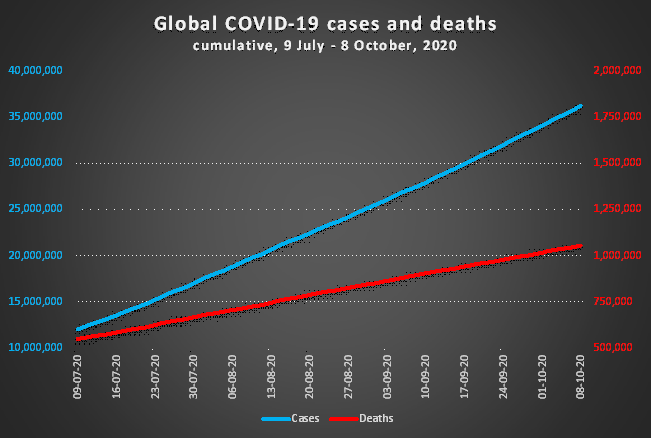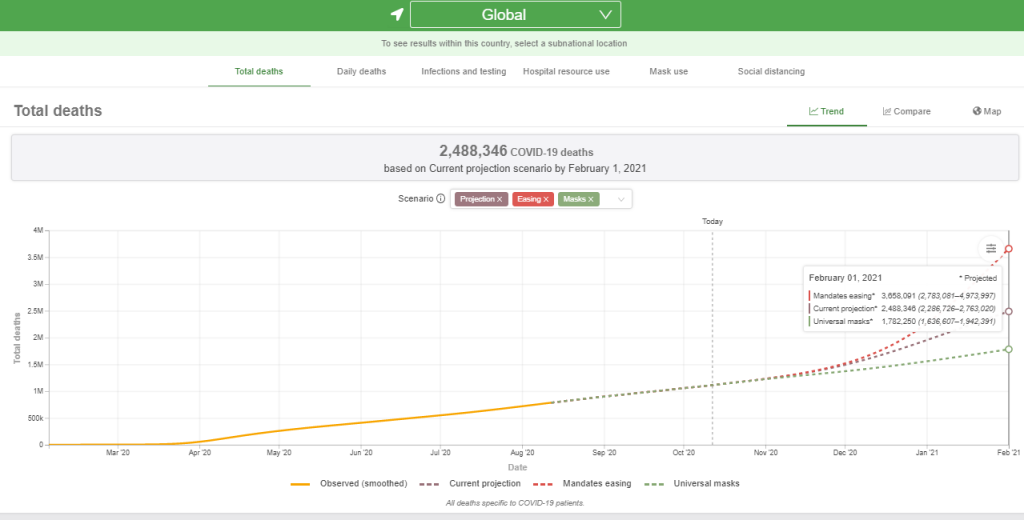The perils of predicting death. Reflecting on 1,000,000 and 2,000,000
The World Health Organization usually proceeds with caution. It carefully weighs arguments and evidence, and does not jump to conclusions. Its declarations and statements seem wrapped up in diplomatic language. Some would call the organization political and slow, too slow for pandemic times.
Only early June, the WHO changed its stance on protective masks. For the first time, it issued the advice that masks should be worn wherever social distancing is not possible. One month later still, it took an appeal of 240 scientists to have the WHO acknowledge the importance of aerosols as a main pathway of virus transmission.
So when on September 25, while the virus was about to claim its one millionth victim, WHO’s executive director Dr Mike Ryan said that it was “not impossible’’ the global death toll could reach 2 million people by mid-2021, that sounded like an uncharacteristically audacious remark. But was it really?
It’s difficult to make projections, especially about the future. Even in pre-pandemic times there was more than a touch of truth to that statement. One of the people who does not shy away, however, from making bold statements, is US President Donald Trump. On April 20, he predicted that by the end of the pandemic 60,000 Americans would have succumbed to the coronavirus. Less than 10 days later, the estimate was belied by reality. Few realized, however, that Mr Trump’s remarks were not the fruit of mere intuition or positive thinking, but were actually based on a forecast of the Institute for Health Metrics and Evaluation (IHME) one week earlier.
The IHME is a renowned research institute in the field of global health statistics. Like other prognoses at the start of the pandemic, the IHME-models pictured a too optimistic outlook though, especially for the US. These early models were flawed primarily because of a lack of reliable historical data.
Today, the IHME has faced up to a grim reality. It predicts almost 2.5 million deaths by February 1, 2021, based on the global policies employed. On a country level, the model continues to surprise. For the US, the current projections give a death toll of 395,000 by February 1, 1.8 times the actual number. On the other hand, Germany would count by then 62,000 deaths, up by more than 50,000, or 500%. This means Germany would suffer, relative to the size of its population, 15% more losses than the US over the next few months. These numbers suggest that the IHME somehow assumes that some levelling of COVID-19 mortality will ultimately kick in between countries, in line with their population size.
Still before the IHME, predictions of the Imperial College London were the first to draw global attention. The study, published on March 26, looked at various scenarios, differing in the severity of the measures implemented,
Letting the pandemic run its natural course without interventions would cost 40 million lives by the end of this year. The model predicted that, by early adopting an effective suppressing strategy, the number of deaths could be reduced to 1.9 million. It also showed the dire consequences of late implementation of measures. Although one could argue whether the global policy resembles an effective suppression strategy, more than 6 months after its publication the model still looks in touch with reality.

On June 29, the official corona death count passed 500,000. Precisely 3 months later, the world mourned its one millionth victim. The last 3 months, from July onwards, we noticed a striking linearity of the death curve. From July to September, the death toll grew daily by on average 5700. Last month, the slope of the curve slightly dropped to an average of 5300 daily deaths. Extrapolating this trend would imply that the bleak milestone of 2,000,000 would be reached within 6 months, by April 2021. That is: if we were into predicting, which we are not.
Calling 2 million deaths a best-case scenario would be inappropriate, but the horrendous figure seems by now inevitable. And whichever scenario will materialize, the WHO has once more confirmed its penchant for risk-averse statements.
(rvdk)
Sources data
Input data graph COVID-19 cases and deaths: European Centre for Disease Prevention and Control
COVID-19 Projections IHME: covid19.healthdata.org
Cover image
9wooddy via Shutterstock
COVID-19 Projections IHME 12/10/2020


